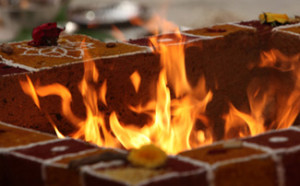 In our tradition, it is customary to light a lamp during the inauguration of any function or occasion. Equally significant is the shloka chant which accompanies the lighting of the lamp.
In our tradition, it is customary to light a lamp during the inauguration of any function or occasion. Equally significant is the shloka chant which accompanies the lighting of the lamp.
शुभं करोति कल्याणम् आरोग्यम् धनसंपदः
शत्रुबुद्धिविनाशाय दीपज्योतिर्नमोस्तु ते
दीपज्योति: परब्रह्म दीपज्योतिर्जनार्दनः
दीपो हरतु मे पापं दीपज्योतिर्नमोस्तु ते
May the Deepa Jyothi bring in auspiciousness, welfare, good health and wealth. May our namaskar be to the Deepa Jyothi for destroying the feeling of enmity in us. Deepa Jyothi symbolizes the Parabrahma as well as the maintainer – Janardana/Lord Vishnu. May the Deepa take away my sins. Namaskar to the Deepa Jyothi.


